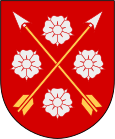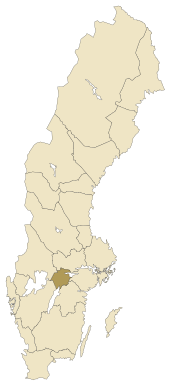Nark
| Nark | |
|---|---|

|

|
| Basic data | |
| Part of the country (landsdel) : | Svealand |
| Province (län) : | Örebro County , Östergötland County , Västmanland County |
| Surface: | 4,884 km² |
| Residents: | 192,229 (December 31, 2008) |
| Population density: | 39 inhabitants per km² |
| Highest elevation: | Kilsbergen 298 m ö.h. |
| Largest lake: | Vättern |
Närke is a historical province ( Swedish landskap ) of Sweden and is located in the part of Svealand .
geography
The province of Västmanland in the north and Södermanland and Lake Hjälmaren in the east connect to Närke . In the south Närke is bordered by Östergötland and Lake Vättern . The provinces of Västergötland and Värmland are to the west of Närke. The area of Närke includes the western half of the Hjälmaren and the northernmost part of the Vättern.
From the north, the almost 300 m high Kilsbergen ridge protrudes into Närke. This ridge continues in the border area to Värmland in a south-westerly direction, where it loses height. Then it rises again and reaches the Tiveden mountain range in the border area to Västergötland . A branch of the Tiveden stretches north-east to Hjälmaren. The Käglan ridge is to the north of Närke . These three mountain ranges enclose a larger agricultural plain.
history
When the Norwegian King Olav II had to go into exile between 1028 and 1029, he spent some time in Närke and probably contributed to the Christianization of the area. In 1170 Närke fell to the diocese of Strängnäs . Around the year 1200, Örebro Castle was built to protect a bridge over the Svartån River . In 1435, the leader of an uprising against Erich von Pomerania , Engelbrekt Engelbrektsson , was assigned the castle of Örebro.
In the 16th and 17th centuries, iron production of major national importance was established in Närke . The local farmers benefited above all from the new industry, as the skin of their oxen was used in many ways in the mines. The leather of the ox was also a reason for the development of a larger shoe industry, which mainly continued until the middle of the 20th century.
There are still some castles from the Middle Ages in Närke. The most important and best preserved is in Tarsta near Sköllersta .
coat of arms
Description: Two gold crossed arrows with silver tips in red, each accompanied by a silver rose in their corners.
Landscape symbols
- Flower: Real cowslip ( Latin Primula veris )
- Animal: dormouse ( Muscardinus avellarius )
- Bird: goldenhammer ( Emberiza citrinella )
- Fish: bleak ( Alburnus alburnus )
- Mushroom: saffron umbrella
See also
literature
- Nark . In: Theodor Westrin, Ruben Gustafsson Berg (eds.): Nordisk familjebok konversationslexikon och realencyklopedi . 2nd Edition. tape 20 : Norrsken – Paprocki . Nordisk familjeboks förlag, Stockholm 1914, Sp. 334 (Swedish, runeberg.org ).
Web links
- Official website (Swedish)
Individual evidence
- ↑ Folkmängd i landskapen ( Memento from August 17, 2013 in the Internet Archive ).